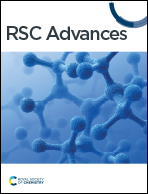Efficient ternary WORM memory devices from quinoline-based D–A systems by varying the redox behavior of ferrocene†
Abstract
The design and synthesis of ferrocene-functionalized organic small molecules using quinoline cores are rendered to achieve a ternary write-once-read-many (WORM) memory device. Introducing an electron-withdrawing group into the ferrocene system changes the compounds' photophysical, electrochemical, and memory behavior. The compounds were synthesized with and without an acetylene bridge between the ferrocene unit and quinoline. The electrochemical studies proved the oxidation behavior with a slightly less intense reduction peak of the ferrocene unit, demonstrating that quinolines have more reducing properties than ferrocene with bandgaps ranging from 2.67–2.75 eV. The single crystal analysis of the compounds also revealed good interactive interactions, ensuring good molecular packing. This further leads to a ternary WORM memory with oxidation of the ferrocene units and charge transfer in the compounds. The devices exhibit on/off ratios of 104 and very low threshold voltages of −0.58/−1.02 V with stabilities of 103 s and 100 cycles of all the states through retention and endurance tests.



 Please wait while we load your content...
Please wait while we load your content...